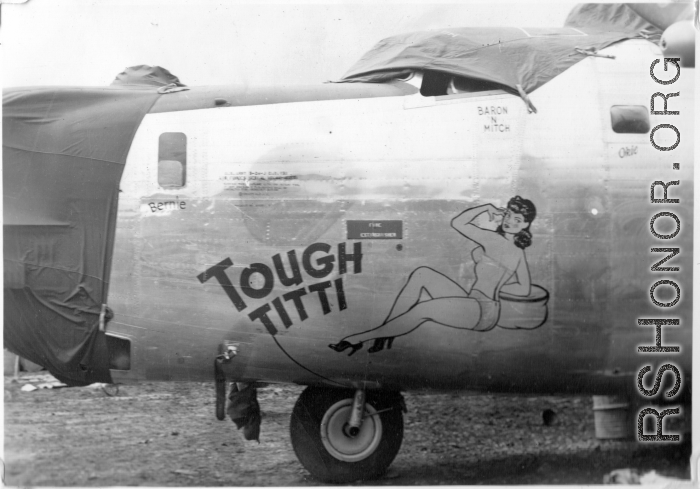B-24 "Tough Titti" in CBI during WWII.
"On January 15, 1997, the news media reported of a search team investigation the crash of a World War II heavy bomber into a 7,000 foot mountain in Southern China returning for its second bomb run. As I read the report and watched television, I realized that it was one of the B-24 Liberators from my 308th Heavy Bomb Group of the 14th Air force. This was the group I served with in China during 1943 & 1944 as a radar technician repairing and calibrating the various radar sets in each plane.
As I continued to follow and watch the story, I saw a television picture of the crew taken in front of the plane. A portion of the plane's name appeared above the crew member's heads. I immediately recognized it. I found my photo album of that part of my life and there was the picture with its name, "Tough Titti," completely visible. It is possible that I may have worked on the radar in that plane. The news account didn't identify the plane's squadron, so I am not sure because I don't remember all the plane on which I worked.
During the time I was there, bad weather, poor maps, and human error, accounted for the loss of most of our bombers, not enemy fire. The majority of the strikes by the planes equipped with radar were carried out at night over the China Sea. When the planes arrived there, and found a target, the bomb runs were made at an altitude of no more than 400 feet, and used Low Altitude Bombing (LAB) radar to hit the target. Leaving from fields at and near Kunming, China, the planes had a round trip flight of at least 14 hours. To complete the mission, it was necessary that one bomb bay carried an extra fuel tank rather than bombs. For all these reasons, I declined the 14th Air Force’s monthly offer to become a member of a flight crew. I didn’t think it was an intelligent alternative to what I was then doing.
In China, we fought a small and strange war. Everything we needed of a technical nature, plus gasoline, had to be delivered by the Burma Road or be flown over the Himalaya Mountains from India. Most of our needs were provided by the Air Transport Command (ATC). Every day, there was a constant stream of ATC planes flying over the mountains to and from India. Frequently, our bombers were converted to cargo planes with four fuel tanks in the bomb bays and assisted the ATC in ferrying gasoline and supplies from India to China. When enough gasoline had been brought from India, and the weather permitted flying, the 14-hour bomb runs were made to the China Sea. Our radar bombing ws very accurate and accounted for the sinking of a vast amount of Japanese shipping. Our unit was awarded the Presidential Unit Citation for the tonnage sunk.
The only method used to find and sink the targets were radar search and bombing sets. No visual contact was ever made. Confirmation of ships sunk were photographs of a separate radar screen showing a blip produced by a ship, and the subsequent disappearing of the blip when the ship sank.
Vern P. Martin”
